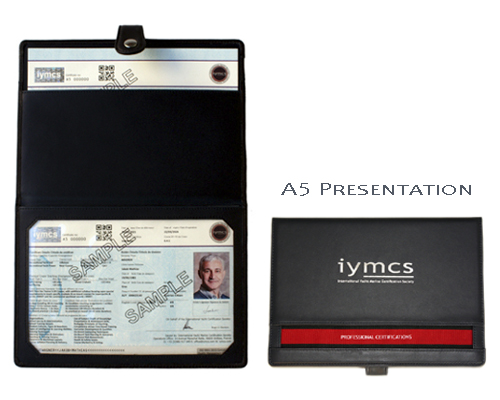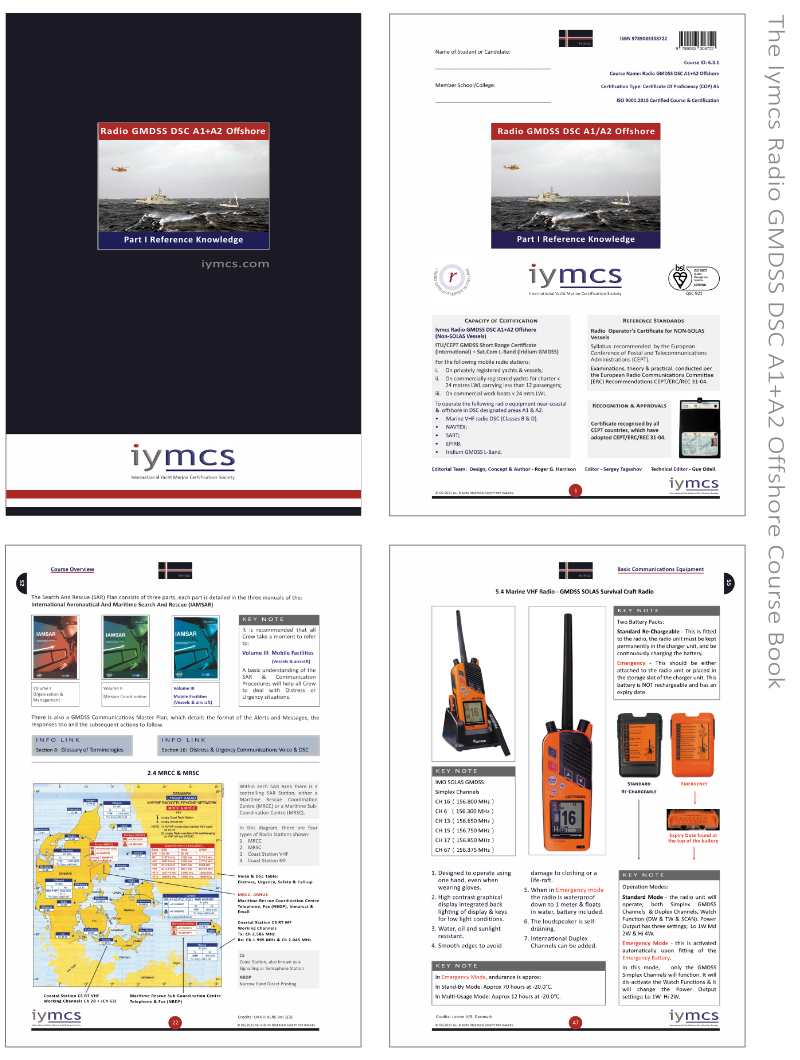
| General Details |
|---|
| Course & Certification:
ID: 6.3.1 Description: Radio GMDSS DSC A1+A2 Offshore Certification type: Certificate of Competency ISO 9001:2015 compliance course & certification. |
| Course Length:
A total of 33 hours consisting of; Pre-Course study = 1.5 hours |
| Capacity of certification:
Radio Operator's Certificate for NON-SOLAS Vessels. For the following mobile radio stations: On privately registered yachts & vessels; To operate the following radio equipment near-coastal & offshore in DSC designated areas A1 & A2: Marine VHF radio DSC (Classes B & D). AIS. NAVTEX. SART. EPIRB. Sat.Com L-Band Iridium GMDSS. |
| Recognitions & approvals:
Certificate recognised by all CEPT countries which have adopted CEPT/ERC/REC 31-04. |
| Reference Standards:
Syllabus recommended by the European Conference of Postal and Telecommunications Administrations (CEPT). |
| Certification Revalidation:
Required every 5 years with the undertaking of a 3.0 hours refresher course on a 2-station simulator. |
| Sea-time requirements:
None. |
| Certification issuing requirements:
None. |

The custom-designed iymcs presentation folder type certification is stylish and practical.
The presentation folder outer is made of real leather with a sythentic interior that is resistant to water and protects the certificates.
It is A5 in size, it can hold up to four Certificates, and is an ideal size to be kept in a crew document case or with the boat's documents.
The iymcs Certificates are printed to ISO 9001:2015 standards, are dual-language and feature extensive security features
to security level 3 (Government passports & national identification documents are security levels 1 & 2) and can be used as a personal ID in daily situations.
(Nb. It cannot be used instead of a passport/national identity card).
The Iymcs Radio GMDSS DSC A1+A2 Offshore Course focuses upon safety and general communications to operate a mobile radio station, non Full-SOLAS compliant, on:
| Privately registered yachts & vessels. | Commercially registered yachts for charter <24 metres LWL carrying less than 12 passengers. | Commercial work-boats <24 mtrs LWL. |
Operating in designated DSC Sea Areas of A1 or A2, coastal and offshore.
This advanced level course covers focuses upon GMDSS communications in complex scenarios, and/or in difficult sea and weather conditions: Making it suitable for offshore crew, whether they be professional or recreational. Lightening formation, prevention, strikes and precauations to take: Are all covered in detail.
The syllabus covers in full the ITU/GMDSS recommendations for the SRC DSC, international version, and partially the syllabus for the LRC course. Offshore communications is centred upon the usage of Sat.Com L-Band (Iridium GMDSS) and marine VHF radio between vessels, MRCCs and Coastal Radio Stations.

The competent use of the phonetic alphabet and Standard Marine Communication Phrases (SMCP) is an important emphasis of this course. The co-ordination of voice messages and DSC alert & messaging is covered between marine VHF and Sat.Com Iridium GMDSS. The configuration, testing, activation and detection are covered in detail for EPIRBs and SARTs. The distribution of MSIs is explained in detail, there is a NAVTEX Operations Section. There are Sections covering radio equipment testing & maintenance and the protection of distress frequencies.
A 2-station simulator is used for you to practice exercises. It is important to practice the transmission effectively of a message either by digitally or voice, as well as practice the procedures to follow upon reception of the same.
This course is ideal for crew that are looking to cruise offshore who need a good working knowledge of the complete GMDSS structure & its workings.

Our Society, the 'International Yacht Marine Certification Society" (Iymcs) operates its entire operations under a Quality Management System
(QMS) that is in compliance with the International Standards Organisation (ISO) 9001:2015 amended. Part of this compliance involves full auditing procedures.
This is an important reference and enables us to gain recognitions from maritime administrations and marine industry bodies alike.
The QMS together with the ISO, ensures that iymcs and its Members operate to the highest standards possible. All our courses, and more importantly the
Certifications that we issue, are under ISO9001:2015.
This practice is most unusual to see for such courses and certifications. It ensures a uniform and consistent quality standard throughout the Society's operations.
| Scandinavia 790,-EUR | Northern Europe 735,-EUR | United Kingdom 490,-GBP |
| Southern Europe 635,-EUR | Middle East 690,-USD | North America 690,-USD |
| Prices exclude: course books,certification costs,personal traveling costs,course food and course accommodation. | ||
( Vers. 2.2. CEPT/ERC.) Click-on '+' to see Syllabus.
Science of radio waves (A1.1.3). Radio wave propagation (A1.1.3). Ground waves and sky waves propagation (A1.1.3). Tx & Rx ranges (A1.1.3). Marine VHF Radio Telephone installation (B3.3.2 & 3.3). Interfacing connection to a positioning device (B3.3.2). Antenna coaxial cable & thru-deck cable connectors. GMDSS, ITU & SOLAS. Distress Mayday history & background of.
GMDSS Structure (A2.2.1). GMDSS Sea areas (A2.2.1). SAR Organisation (A3.3.3). MRCC & MRSC (A3.3.2)..
Radio frequency and bands. Simplex, Semi-duplex & Full-duplex operations (A1.1.3). Transmission and receiving distances (A1.1.3). Types of Communications (A1.1.1). Channel types, Categories & Usages (A1.1.3).
Types of Aerials. Antenna performance & positioning. (B3.3.1). Antenna Gain. Types of Antenna. Antenna Interfacing Units. WiFi Antenna Group. Standing Wave Ratio Meter. Lightening.
Marine VHF Radio - Mobile Station Units (B1.1.3). Marine Headsets & Microphones. Marine VHF Radio - Handheld Units (B1.1.3). Marine VHF Radio - GMDSS SOLAS Survival Craft Radio. On-Board Radio UHF - Handheld. NAVTEX Receiver (A4.4.1). Emergency Position-Indicating Radio Beacon (EPRIB) (C3.3.1 + C2.2.6 + C3.3.2). MOB Personal Location Beacon (PLB). Search & Rescue Transponder (SART) (C3.3.2 + C3.3). Satellite Communication Phones - Handheld & Mobile Units. Sat.Com Inmarsat C & Iridium GMDSS. GMDSS Radio Installations.
DSC - History & Development. Maritime Mobile Service Identity Number (MMSI). National ID - Maritime Identification Digits (B2.2.3). MMSI N°s - Ship Station (B2.2.3). MMSI N°s - Coast Station (B2.2.3). MMSI N°s - Group Call (B2.2.3). MMSI N°s - EPIRB AIS & SART AIS Beacons. MMSI Resources.
AIS - System. AIS - Channel & Frequency Allocation. AIS - On Board Equipment & Installation. AIS - Transceivers, Transponders & Receiver Units. AIS - Principal Functions & Cautionary Points. AIS - Data Transmissions. AIS - Data Error & Implications.
Satellite GMDSS Overview. Inmarsat - History & Organisation. Inmarsat - Footprint. Inmarsat - C & Mini C. Iridium - History & Organisation. Iridium - Satellite Network. Iridium - GMDSS. SatCom Phones.
Principal Controls (B1.1.2). Initial Switch-On and Operator Procedure. Power Outputs. Dual-Watch, Tri-Watch & Scan-Watch (B1.1.1). Channel 16 (A1.1.3). Primary International Channels (A1.1.3). VHF Channels & Frequencies (A1.1.3). Adverse Meteorological Conditions. DSC System, Alert & Messaging DSC (B2.2.2 & B2.2.4).
Ships Radio Station Licences. Radio Operator Certifications (E1.1.2). Types of Radio Stations (A1.1.2). ITU International and Regional Channel Lists (E1.1.2). ITU/GMDSS Regulations of Operations & Good Practices (E1.1.2). Vessel Identification (D2.2.1) & MMSI (B2.2.3). GMDSS Radio log (E1.1.2)
Official ITU & GMDSS Publications. International Code of Signals. Independently Published Yacht; Cruising Guides, Pilot books, Charts. UKHO Admiralty Sailing Directions. Electronic Chart Plotters (ECS) Information Inserts/Boxes. Official Online Internet Resources.
The International Phonetic Alphabet (D1.1.5). International Marine Communications Procedure Words (D1.1.4). Communication Phrases Exercises. Phonetic Alphabet Exercises.
Com procedures ship to ship (B2.2.1 & D2.2.1). Com procedures ship to MRCC or MRSC (A3.3.4 & D2.2.1). Com procedures ship to coast station (D2.2.2). Com procedures ship to VTS Control station (D2.2.2). Com procedures ship to Aircraft station. Traffic Lists. Traffic Charges (D2.2.3). Radio Procedures Cards.
The Col.Regs (IRPCS). Efective Communication Criteria. Ship-to Ship Procedure. Specific Procedure Words & Phrases.
On-board Communications - UHF Handheld (C3.3.3). Tender/Auxiliary Communications - VHF Handheld & Fixed (C3.3.3). Communication Ranges (C3.3.3). Battery Provisions (C3.3.3). Message Relay.
Distress Mayday Situation - Definitions. Distress Mayday Situation - Determining. Distress Mayday - Alert & Message Content (B2.2.1 & C1.1.1). Distress Mayday - Tx Procedures (C1.1.1). Distress Mayday - Response Procedures (A3.3.4 & C2.2.2). Distress Mayday - Relay Procedures (A3.3.4). Distress Mayday - Cancellation Procedures. Obligation to Assist a Vessel, Aircraft or Person/s in Distress. Urgency Pan Pan - Definitions. Urgency Pan Pan - Tx Procedures (B2.2.1 & C1.1.2). Urgency Pan Pan - Response Procedures (A3.3.4). Urgency Pan Pan - Cancellation Procedures.
Reference Publications. Telemedical Advice Services (TMAS) TMAS Assistance - Patient Information. Medical Advice - Standard Phrases. Urgency Pan Pan (Medico/Medical) Message - Tx Procedures (D1.1.2).
Safety Sécurité Message - categories (D1.1.3). Safety Sécurité Message - content (B2.2.1 & D1.1.3). Safety Sécurité Message - Rx & Tx procedures Safety (C1.1.2 & D1.1.3).
NBDP Principles (A4.4.1). Message Format & Categories (A4.4.1). Messages which cannot be rejected (A4.4.1). Message Record Keeping. NAVTEX Stations & Frequencies (E1.1.1). Installations. Set-Up & Operating Procedures (A4.4.1).
Marine VHF Channel Development. Frequency Guard Bands (C2.2.1). Guard Frequencies & Avoidance of Transmissions (C2.2.1 & C2.2.5). Test Protocols & Procedures (C2.2.4). Cancellation Procedures for False Distress Alert Transmitted (C2.2.6). Prevention of Unauthorised Transmissions (C2.2.3). Distress and Urgency CH 16 Frequency Blocked.
Daily set-up and testing. Basic fault finding. Certificate expiry dates Connection to different power sources ((B3.3.3). Requirements & Safety (B3.3.3). Charging (B3.3.3). Maintenance of batteries (B3.3.3).